BREAKING: One person shot and seven arrested in Ferguson after curfew, officials say: photo via NBC News on twitter, 17 August 2014
"Who you out here for? Better be for Mike Brown." Protesters guarding a liquor store from looters early Saturday a.m.: photo via Trymaine Lee, on twitter, 16 August 2014
CONFIRMED: Tear gas deployed against Ferguson protesters -- police: photo via RT on twitter, 17 August, 2014
Bobby Seale: We built it out of anger and desire and need
Drawing
for CBS Evening News of Bobby G. Seale with Arnold F. Markle, State
attorney for the Judicial District of New Haven, in the background:
Robert Templeton, 1971, oil pastel, 24.6 x 20.3 cm., from Drawings and
sketches related to the trial of Bobby Seale and Ericka Huggins, New
Haven, Connecticut (Beinecke Rare Book and Manuscript Library, Yale
University)
You have to remember, the Party at one time had 5,000 active members in 45 cities throughout the United States of America.

Man on the steps of the Lincoln Memorial holding a banner for the Revolutionary People's Constitutional Convention, at Black Panther Convention: photo by Thomas J. O'Halloran/Warren K. Leffler, 19 June 1970
45 chapters and branches of the Black Panther Party. The peak of that
was January 1969. The Party was almost two and a half years old. Started
in October 1966. We had international notoriety seven months later, May
2, 1967.

Martin Luther King, Jr. and Malcolm X, Washington, D.C.: photo by Marion S. Trikosko, 26 March 1964 (U.S. News & World Report Photograph Collection, Library of Congress)
Martin Luther King was killed April 6, 1968. Up to Martin Luther
King I only had 400 members up and down the West Coast, San Diego to Seattle.

Riot damage in D.C.: the ruins of a store in Washington, D.C., that was destroyed during the riots that followed the assassination of Martin Luther King, Jr.: photo by Warren K. Leffler, 16 April 1968
When
Martin Luther King was killed, in a matter of a couple of months,
particularly when the colleges let out, it blew my mind that so many
young people started flooding into our organization.

D.C. riot. April '68. Aftermath. A soldier standing guard on the corner of 7th & N Street NW in Washington D.C. with the ruins of buildings that were destroyed during the riots that followed the assassination of Martin Luther King, Jr.: photo by Warren K. Leffler, 8 April 1968 (Library of Congress
They were so angry
that brother Martin Luther King was killed.

Washington D.C. riot, April 1968, Aftermath: members of the D.C. National Guard patrolling streets as pedestrians walk by: photo by Warren K. Leffler, 8 April 1968 (Library of Congress)Washington D.C. riot, April 1968, Aftermath: members of the D.C. National Guard patrolling streets as pedestrians walk by: photo by Warren K. Leffler, 8 April 1968 (Library of Congress)
They
said, ‘I’m joining the Black
Panther Party.’ So we had an influx, 60% of that membership being
particularly college students, high school students headed to college
who decided to postpone their college education.

Smoke rises near U.S. Capitol, during riot, 1968. (Photographer's note: "D.C. Riot, April, '68: After curfew deserted streets in D.C. -- Smoky sky w/capitol -- damaged area."): photo by Marion S. Trikosko, 6 April 1968
In
a matter of five or six months following the death of Martin Luther King, we had peaked at
5,000 active full-time members of the Black Panther Party.

"Don't work" sign promoting a holiday to honor the anniversary of the assassination of Martin Luther King, Jr., on a shop on H Street, N.W., Washington, D.C.: photo by Marion J. Trikosko, 3 April 1969
Plus our working coalitions
had expanded to a point that by 1969 we were able to create what we called
the National Committees to Combat Fascism as an extension organizing
effort beyond the Black Panther Party, we didn’t care whether you
was white,
black, blue, red, green, yellow, polkadot, anyone could be a community
worker with the NCCF. And that group was composed of almost 10,000 more
people.

Bobby Seale, San Francisco: photo by Robert Altman, May 1969
This
was why the power structure was really afraid of us, about that.
Because to mobilize those kind of people, to mobilize those
brothers and sisters, people who were angry, and to tell them we need to
take over all of these political seats. These political seats, whether it’s a city
council or making legislation, laws and policies, are not serving the
basic desires and needs of the people. So we the young political
revolutionary humanists, we can get in there. We’re saying the same
thing as to exist now -- in the context of the present, though.
Bobby Seale: photo by Risa Staszewski. 25 February 2006
Black Power, Ferguson: photo by July 27 on twitter, 15 August 2014
You have to remember, I come up in the high-tech world.

Ferguson: photo by AP via The Independent, 14 August 2014
Before
I ever got involved with this stuff, I was working on the Gemini
missile project in the engineering department at [inaudible] Aerospace
and Electronics. I was doing electromagnetic field, black light,
non-destruct testing for all the engine frames for the Gemini missile
program. For all three stages of exhaust housing for the Gemini missile
program.
Gemini spacecraft diagram: image by NASA, 26 April 1965 (NASA)
I
went to college originally as an engineering design major, and when I
went to college, remember this is AFTER the four years in the United
States Air Force, structural repair, high-performance aircraft for the
USAF, so … raised a carpenter and a builder…architect by the time I’m
18. So I based everything in my life and my understanding, even by the
time I got in college, based on it on good, proven, scientific
evidentiary fact.
View of the tracking screen at the front of the Mission Control Center during the Gemini-5 spaceflight: image by NASA, Augustl 1965 (NASA)
So when the Nation of Islam, as religious Black nationalist-type of
organization was propagating some very mythical misunderstanding, it’s
not scientific fact for me. I have no time for it, you know what I mean?
I did respect their call for financial self-sufficiency in the Black
community, etc., but in terms of having an organization, we refused to
have religious and/or myopic, xenophobic Black nationalists as the
ideology or as any part of, we didn’t want that as the head, or the
leading ideological notion.
Missouri governor declares state of emergency and curfew in Ferguson: photo via Saulo Corona on twitter, 16 August 2014
What happened was that in forming the Black Panther Party, Huey and I
came up with what we called a functional definition of power. In those
days, people were spouting in 1964 or ’65 or ’66, “Black power! Black
power!” There was so much rhetoric, you see what I mean. It was
so much TALK, it was not really being put together. Huey and I set the
word “black” to the side for a minute to come up with a functional
definition of the term “power.” And we came up with “Power is the
ability to define phenomena and then in turn, make them act in a desired
manner.”

Demolition, Deaconess Hospital, Dogtown (St. Louis): photo by chalkdog, 22 April 2014
What I’m getting at here, this is like three-dimensional to
me. An engineering design major, an architect, I think three
dimensional. [That definition], oh my god, it’s metaphorical, it’s
applicable to understanding what the situation is. If the city council
are a bunch of low-life avaricious racists, bang! We have defined them for what they are.
Now we must unite all the people, vote they butts out of office and
make them in turn act in a desired manner, giving greater people’s
community political representation power. So this is where we came from.
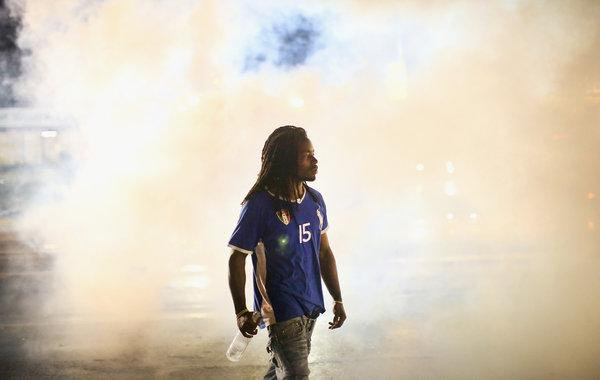
Protester,
Ferguson: photo via Chicago Tribune on twitter, 15 August 2014
So our point was, I think it was a pivot point when we came up with that definition, we looked at and began to see a class
analysis, in the sense that it was not only black people that were
being oppressed, we had poor whites who were oppressed, poor
Mexican-Americans who were oppressed, Native Americans, etc. Crossing
the racial lines.
And that's
why we moved not for some Black nationalist, xenophobic-type separatist
ideology. Two, I didn’t think that way. Ohmigawd, gimme a break, you
know. I looked at the world as being interconnected and interrelated.
Thinking three-dimensional. See, we were part of a young Black
intelligentsia. We were researchers. We were avid readers. We took time
to know. You couldn’t just come up with some platitude, some emotional
speech, ha ha ha, to get us all hooked up. Cuz we would question
it. “Where you going with it? What do you mean by…?” So much theory.
“Well how you gonna put that theory into practice?” In other words: I’m
an architect. When I draw and lay out the plans for building a
structure, those plans are only theory for the idea, right? [But] When I
build the building, it’s real. You have to put it in practice.
After kicking out the police, the people of Ferguson took back their streets: photo via Allah akbar on twitter, 16 August 2014
So you have to put all that together and you can see where we came from. The separatist ideology was absurd. And I used to tell people, “No, we’re not
outside the system.” “Oh yes you are.” I says, “Agnew said that!”
Agnew, the vice president of the United States, part of a corrupt
political structure, telling people we were outside the political
system. Which was bullcrap, when we’d already ran for political office. How can you be outside of something that’s oppressing you, I would tell people. “Oh
that’s right, how can you be outside of something…”
Then I’d ask the
white left radical buddies one time, after Bobby Kennedy was killed,
[they were saying] “Oh no Bobby, man, we’re tired of the System, man.
We’ve droppedout, man.” I says, “You can't drop out. You cannot
drop out of the total system. We have to get rid of the avaricious
corporate monopoly capitalism. We have to get rid of the
institutionalized framework of racism in America. Those two aspects we
must fight against.” “No we’ve dropped out!” I sez, “You think you can
drop out of the total System? cuz everything is interconnected
and interrelated, then you take all your buddies, go down to Cape
Canaveral, I want you to hijack one of those rockets, take your butt to
the moon. When you get to the moon, the president of the united states,
Tricky Dick Nixon, is gonna send some troops up there, bring you back.
There is no such thing as dropping out of the total system!” So my point
becomes you must struggle to change the frameworks, the institutions and make those institutions make human sense.

Ferguson: photo by AP via The Independent, 14 August 2014
So
this is the argument and this is where we came from in the 1960s. I
mean, yeah we were political revolutionaries, yeah we identified a
racist for what he was, and if we said “Black power” as fast as we said
“Black power” we said “Red power” and as fast as we said “Red power” we
said “Brown power”, “white power” and then we summed it up with “All
power to all the people.” See what I’m getting at? So this is where we
came from.
Bobby Seale, from an interview by Jay Babcock, Oakland, 17 March 1999
Bobby Seale: photo by Risa Staszewski. 25 February 2006
A police officer and a protester have a tense moment before a scuffle breaks out between a different protester and police officers near the port during an "F the Police" march held on August 15, 2014 in Oakland, California in solidarity with Ferguson, Missouri, where there was a fatal shooting of an unarmed 18-year-old black man earlier in the week: photo by Leah Millis / San Francisco Chronicle, 15 August 2014

A woman tries to pull a protester away from police after a scuffle breaks out during a march in Oakland against police brutality held in solidarity with the demonstrators in Ferguson, Missouri: photo by Leah Millis, / San Francisco Chronicle, 15 August 2014

One protester helps a woman up after she was involved in a scuffle between police and a protester during an "F the Police" march in Oakland, California held in solidarity with Ferguson, Missouri, where there was a fatal shooting of an unarmed 18-year-old black man earlier in the week: photo by Leah Millis / San Francisco Chronicle, 15 August 2014
Looks like the 1950s to me: photo via Warp Drive on twitter, 16 August 2014
If there were any doubt about police presence tonight: photo via Amy K. Nelson on twitter, 16 August 2014
Store owners in Ferguson say they're going to start defending themselves against looters: photo via Kennan Oliphant on twitter, 16 August 2014
Police, Ferguson: photo via The National Memo on twitter, 13 August 2014
State of emergency, curfew declared in Ferguson: photo via The Chronicle Herald on twitter, 16 August 2014

Ferguson: photo by AP via The Independent, 14 August 2014
Ferguson: photo via Ward Harkavy on twitter, 16 August 2014

Ferguson: photo by AP via The Independent, 14 August 2014
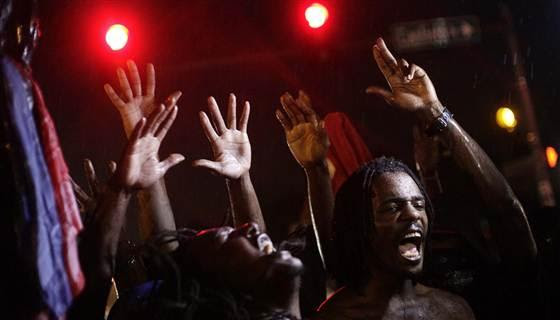



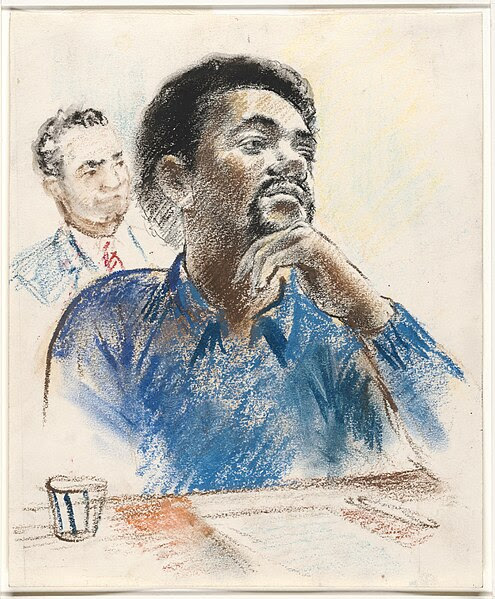
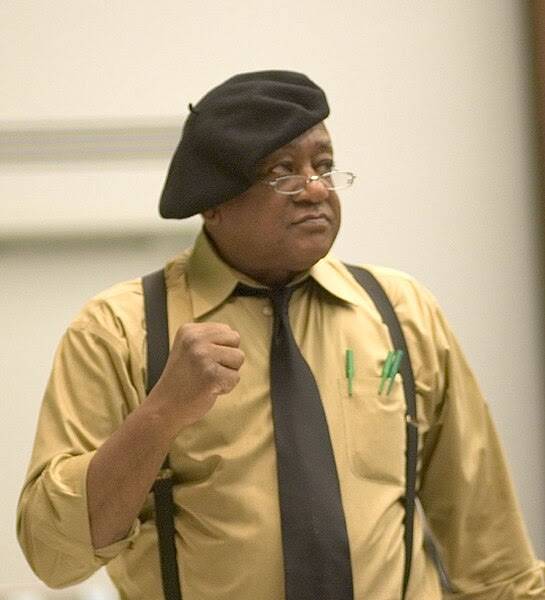





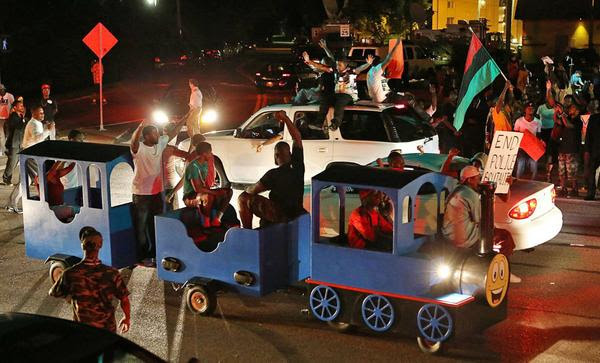


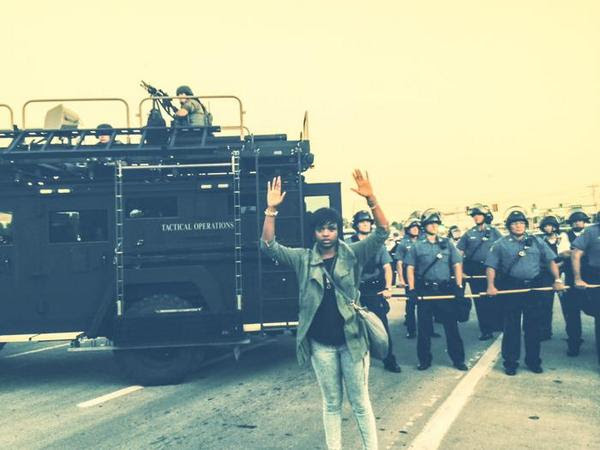


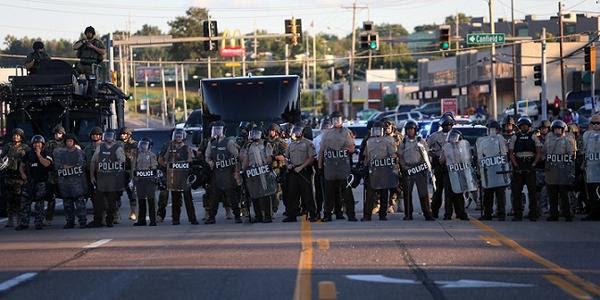





9 comments:
Thanks again, Tom. I'd just like to remember Fred Hampton. as ever, Tom
Make those institutions make human sense
Yes. The only thing worth working for.
That the current order of things is not reasonable or the only way of doing things: it's important to keep these facts to mind
Ferguson seems as much about class war as it does about racism . . . a breakdown in the system of social control; a warning sign that the soma is no longer working to lull the masses into passive acceptance of their fate. The escaltion of police force serves as an example to cops everywhere that class and racial lines will be kept intact. Ferguson is a challenge to the system's control of people, who in an earlier time might have called “workers”, but now, under a globalized, totalitarian economy, are little more than supernumerary bodies.
Many thanks, friends.
The America that welcomed the poor starving huddled masses of the world was replaced long ago by the Big Cop. This remains a racist country. This is a country dominated and controlled by the propertied classes. In their view, the country is their property, as is, by extension, the world. The steroidal accelerated development of the defense and weapons industries supplying the heavy armaments required to subdue a town, a nation, or a world will soon have turned the war governments into roving guardians of walled encampments of protection of the privilege of the very few.
The heroic efforts of the Panthers to operate effectively in this murderous arena were founded in discipline, education, organization.
About Fred Hampton... some who are not old enough to recall those times might consider his story.
In 2009, on the fortieth anniversary of his murder, he was remembered by Democracy Now:
__
As host Juan Gonzalez reminds us, in 1969 Hampton "had emerged as the charismatic young chairman of the Chicago Black Panther Party... On December 4th, 1969, Chicago police raided Fred Hampton’s apartment, shot and killed him in his bed. He was just twenty-one years old. Black Panther leader Mark Clark was also killed in the raid. While authorities claimed the Panthers had opened fire on the police who were there to serve a search warrant for weapons, evidence later emerged that told a very different story: that the FBI, the Cook County state’s attorney’s office and the Chicago police conspired to assassinate Fred Hampton. Noam Chomsky has called Hampton’s killing “the gravest domestic crime of the Nixon administration.” This is some of Fred Hampton in his own words.
__
FRED HAMPTON: So we say — we always say in the Black Panther Party that they can do anything they want to to us. We might not be back. I might be in jail. I might be anywhere. But when I leave, you’ll remember I said, with the last words on my lips, that I am a revolutionary. And you’re going to have to keep on saying that. You’re going to have to say that I am a proletariat, I am the people.
A lot of people don’t understand the Black Panthers Party’s relationship with white mother country radicals. A lot of people don’t even understand the words that Eldridge uses a lot. But what we’re saying is that there are white people in the mother country that are for the same types of things that we are for stimulating revolution in the mother country. And we say that we will work with anybody and form a coalition with anybody that has revolution on their mind. We’re not a racist organization, because we understand that racism is an excuse used for capitalism, and we know that racism is just — it’s a byproduct of capitalism. Everything would be alright if everything was put back in the hands of the people, and we’re going to have to put it back in the hands of the people.
With no education, the people will take the local foundation and start stealing money, because they won’t be really educated to why it’s the people’s thing anyway. You understand what I’m saying? With no education, you have neocolonialism instead of colonialism, like you’ve got in Africa now and like you’ve got in Haiti. So what we’re talking about is there has to be an educational program. That’s very important. As a matter of fact, reading is so important for us that a person has to go through six weeks of our political education before we can consider himself a member of the party able to even run down ideology for the party. Why? Because if they don’t have an education, then they’re nowhere. You dig what I’m saying? They’re nowhere, because they don’t even know why they’re doing what they’re doing. You might get caught up in the emotion of this movement. You understand me? You might be able to get them caught up because they’re poor and they want something. And then, if they’re not educated, they’ll want more, and before you know it, they’ll be capitalists, and before you know it, we’ll have Negro imperialists.
[FRED HAMPTON continues:]
We don’t think you fight fire with fire; we think you fight fire with water. We’re going to fight racism not with racism, but we’re going to fight with solidarity. We say we’re not going to fight capitalism with black capitalism, but we’re going to fight it with socialism. We’re still here to say we’re not going to fight reactionary pigs and reactionary state’s attorneys like this and reactionary state’s attorneys like Hanrahan with any other reactions on our part. We’re going to fight their reactions with all of us people getting together and having an international proletarian revolution.
Black people need some peace. White people need some peace. And we are going to have to fight. We’re going to have to struggle. We’re going to have to struggle relentlessly to bring about some peace, because the people that we’re asking for peace, they are a bunch of megalomaniac warmongers, and they don’t even understand what peace means. And we’ve got to fight them. We’ve got to struggle with them to make them understand what peace means.
Bobby Seale is going through all types of physical and mental torture. But that’s alright, because we said even before this happened, and we’re going to say it after this and after I’m locked up and after everybody’s locked up, that you can jail revolutionaries, but you can’t jail the revolution. You might run a liberator like Eldridge Cleaver out of the country, but you can’t run liberation out of the country. You might murder a freedom fighter like Bobby Hutton, but you can’t murder freedom fighting, and if you do, you’ll come up with answers that don’t answer, explanations that don’t explain, you’ll come up with conclusions that don’t conclude, and you’ll come up with people that you thought should be acting like pigs that’s acting like people and moving on pigs. And that’s what we’ve got to do. So we’re going to see about Bobby regardless of what these people think we should do, because school is not important and work is not important. Nothing’s more important than stopping fascism, because fascism will stop us all.
A brief word about Bobby Seale. Bobby was born into American poverty in Texas in 1937. During WW II his family moved to Oakland. He dropped out of Berkeley High and joined the USAF in 1955. He served three years before a disagreement with a commanding officer at Ellsworth Air Force Base in South Dakota landed him in a military stockade. A dishonourable discharge followed. Thereafter he worked as a sheet metal mechanic at several aerospace plants; during this period he took night school classes in engineering and political history at Merritt College, completing his high school degree. While attending Merritt, he became a member of a campus Black separatist advocacy group, an affiliation which led to his meeting Huey P. Newton.
I Am Mike Brown: live stream from Ferguson
Streets being cleared, town locked down after curfew goes into effect...(this feed unlikely to stay up long, now...)
Tom,
Thanks for this post. Makes me realize how little is remembered about the BPP and other attempts to organize a resistance to the system. Of the many disturbing things about what is going on in Ferguson is the absence of any sense of organization among the protesters. It's hard to see anything good or lasting coming out of what is playing there now.
-David
David,
I watched Monday evening's live feed all through the night. Compelling and very disturbing.
An extremely tense, chaotic setting, with phalanxes of cops, troopers and soldiers advancing, pulling back, advancing again, bullhorns blaring commands (sometimes contradictory), whacko mechanized sound-projecting weaponry blasting like a million lunatic car alarms, shots going off in the dark, sometimes rubber bullets, sometimes live fire, tear gas and smoke going off everywhere, cameramen and reporters down on the ground choking, hiding in backyards, etc.
But interestingly enough, in that extremely tense, chaotic setting, there was an element of self-policing imposed and enforced by a few local community and church leaders, with the people protesting generally responsive to these promptings and trying to stay calm and out of harm's way.
A protozoan birth of organization and discipline out of the necessity of the moment. That was encouraging. The alternative would have been a massacre... which constantly felt no more than a small spark away.
At one point a column of APCs terrifyingly rolled right through the crowd... which simply parted around them.
And I had the anachronistic thought: would the civil rights movement ever have happened if the likes of Bull Conner had had APCs?
It's a shameful time to be conscious and American, if you're me.
Lights out in BEAU Y Town
Post a Comment